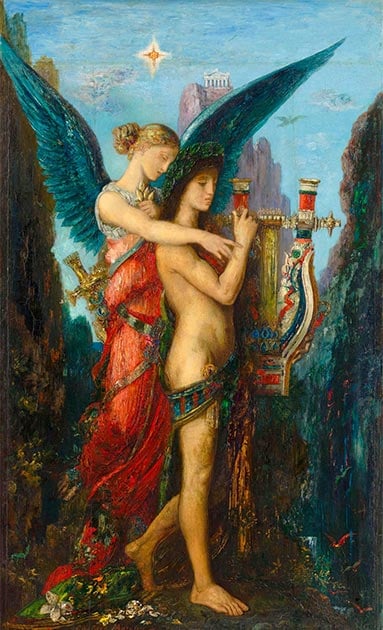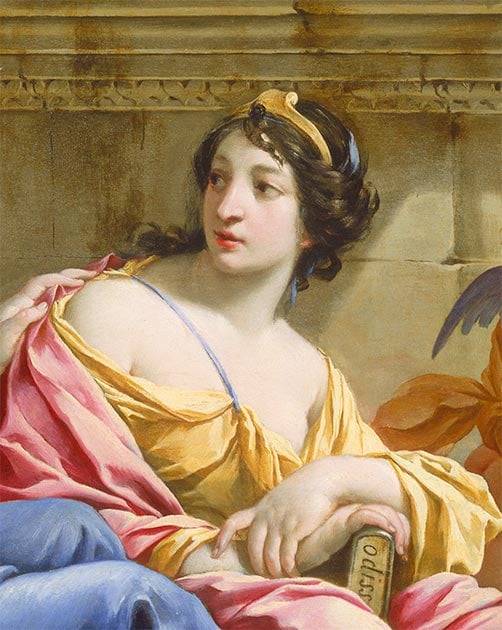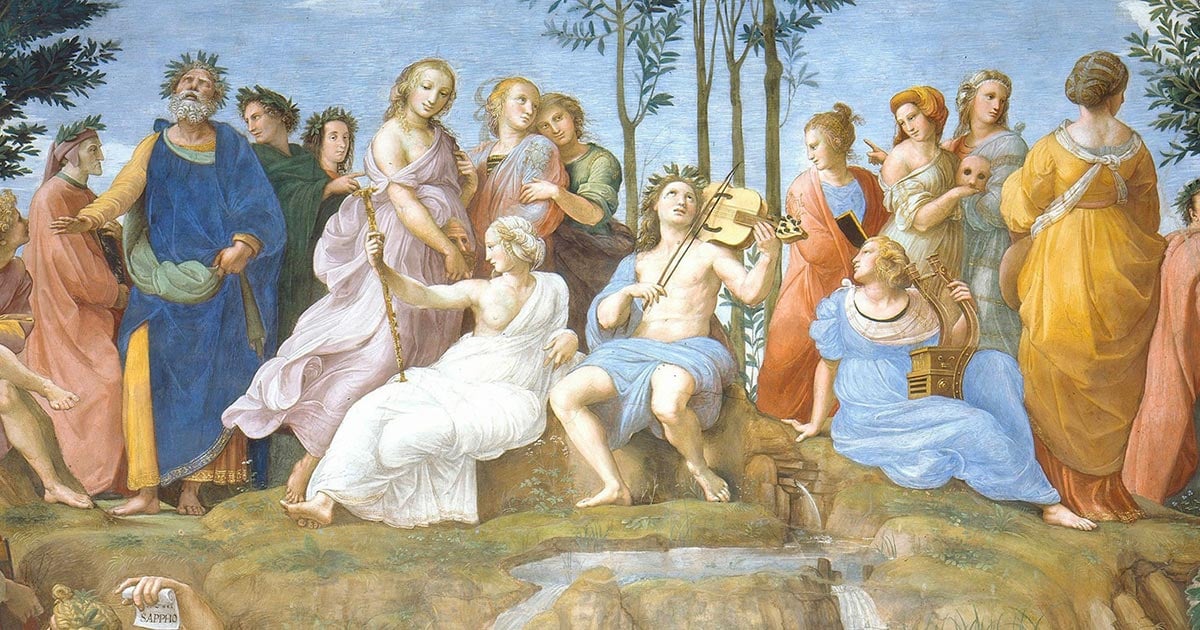The Nine Muses: Daughters of Zeus and Memory, Goddesses of the Arts
According to Classical mythology, the Nine Muses are the daughters of Zeus and Mnemosyne (or Memory). The ancient Greeks and Romans believed that these goddesses granted inspiration to those involved in creative work, such as poets, musicians, and artists. Therefore, the Nine Muses were considered to be the personification of the literary arts, music, and visual arts, and each of them oversaw a particular aspect of the arts.
Today, the domain of the Muses has been extended to include all aspects of art, literature, and science. This is reflected in the word ‘museum’, derived from the Greek mouseion, which originally meant ‘temple or shrine of the Muses’.
The Origin of the Nine Muses
One version of the origin of the Nine Muses is found in Hesiod’s Theogony. In this work, Hesiod wrote “Again, he (Zeus) took love of Memory with her beautiful hair, from whom the Muses with their golden diadems were born to him, nine of them, whose pleasure is in feasts and the delights of song”.
Hesiod provides more detail in another part of his Theogony, “Nine nights Zeus the resourceful lay with her (Memory), going up to her holy bed far away from the immortals. And when the time came, as the months passed away and the seasons turned about, and the long tale of days was completed, she bore nine daughters – all of one mind, their carefree hearts set on song”.

The Nine Muses on a 2 nd century Roman sarcophagus. (Jastrow / Public Domain)
It is rather apt that Hesiod refers to Mnemosyne as the mother of the Muses. The ancient Greeks and Romans believed that this goddess, who was the daughter of Ouranos and Gaia, was in charge of memory and remembrance.
In particular, she is associated with the rote memorization that was necessary to preserve the myths and histories of the ancient Greek before the invention of writing. Therefore, Mnemosyne’s connection with the Muses is quite relevant. Mnemosyne is also considered to be the inventor of language and words, and also a goddess of time.
Although Hesiod’s version of the myth is the most popular one, it is not the only one explaining how the Muses came into being. For instance, the Greek historian Diodorus Siculus refers to the Muses as the daughters of Ouranos and Gaia, while Homer, in the Odyssey, mentions that the Muses were born of Zeus, without making any reference to Mnemosyne.
In addition, while the number of Muses is traditionally said to be nine, the sources differ from one another once more. The Greek traveler and geographer Pausanias, for instance, wrote that originally, there were three Muses – Melete (Practice or Meditation), Mneme (Memory), and Aoede (Song), and that their worship was established by the giants Otus and Ephialtes, known also as the Aloadae, after their step-father, Aloeus. Later on, however, a Macedonian by the name of Pierus of Emathia established the worship of the Nine Muses and changed their names to the ones we know of today.
Where Did the Nine Muses Live?
As for the abode of the Muses, Hesiod mentions that they live on Mount Olympus. Nevertheless, one of their favorite haunts was Mount Helicon, as evident in the first lines of his Theogony, “From the Muses of Helicon let us begin our singing, that haunt Helicon’s great and holy mountain, and dance on their soft feet round the violet-dark spring and the altar of the mighty son of Kronos”.
Helicon is a mountain located in Boeotia, between Lake Kopais and the Gulf of Corinth. According to scholars, Hesiod’s father was from Cyme, an Aeolian city on the coast of Asia Minor, but relocated to Ascra, a village on the eastern side of Mount Helicon.
- The Real Story of Medusa: Protective Powers from a Snake-Haired Gorgon
- Greek mythology and human origins
- The legendary Furies of ancient Greek mythology

Apollo and the Muses on Mount Helicon. (Hohum / Public Domain)
It seems that it was here that Hesiod was born and raised, and hence not entirely surprising that he chose the mountain as the home of the Muses. At any rate, many later writers followed Hesiod’s example.
As mentioned earlier, the Muses had an important role in Classical mythology, serving as the patron goddesses of the various arts. It was from the Muses that the artists of ancient Greece and Rome received their inspiration. This is clearly reflected by Hesiod, who claimed that he was taught to sing by the Muses themselves,
“And once they (the Muses) taught Hesiod fine singing, as he tended his lambs below holy Helicon…. So said mighty Zeus’ daughters, the sure of utterance, and they gave me a branch of springing bay to pluck for a staff, a handsome one, and they breathed into me wondrous voice, so that I should celebrate things of the future and things that were aforetime. And they told me to sing of the family of blessed ones who are forever, and first and last always to sing of themselves.”

Hesiod and the Muse. (Hohum / Public Domain)
The Names of the Nine Muses
The names of the Nine Muses are mentioned by Hesiod, “Clio and Euterpe and Thaleia and Melpomene, Terpsichore and Erato and Polyhymnia and Urania, and Calliope, who is chief among them all”. Each goddess is associated with one particular aspect of the arts and provided with appropriate symbols.
Furthermore, each of the Muses is given a suitable title. The art each Muse is associated with, their symbols, and titles are as follows:
Clio was the Muse of history and she was given the title ‘The Proclaimer’ or ‘The Celebrator’. Her attributes were the scroll, book, and clarion (a type of trumpet).
Euterpe was the Muse of lyric poetry, music, and song and was known also by her title as ‘She who Pleases’. Her attributes were the aulos (an ancient Greek musical instrument that resembles a flute) and other musical instruments she is believed to have invented.
Thaleia was the Muse of comedy and bucolic poetry and was called ‘The Cheerful One’. She is often shown holding a mask of comedy and a shepherd’s staff.

The Muses Clio, Euterpe, and Thalia. (JarektUploadBot / Public Domain)
Opposite Thaleia was Melpomene, the Muse of tragedy, known also as ‘She who Sings’. She is shown holding a mask of tragedy, a sword (or blade), and wearing the cothurnus (a type of boots used by tragic actors).
Terpsichore was the Muse of dance and held the title ‘The One Delighting in Dance’. She is often depicted with a lyre, a type of string instrument. Curiously, despite being the Muse of dance and the title she was given, Terpsichore is normally portrayed sitting and playing the lyre.
Erato was the Muse of love poetry and was called ‘The Lovely One’. She is shown holding a cithara, another type of string instrument.
Polyhymnia was the Muse of sacred hymns and was given the title ‘She of the Many Hymns’. She is depicted with a veil and normally presented as a pensive woman.
- The Spellbinding Story of Circe, Goddess of Magic
- The Greek God Apollo and His Mystical Powers
- Pandora: Unleashing Hell and Hope Upon Humanity

The Muses Melpomene, Erato, and Polyhymnia. (Mattes / Public Domain)
Urania was the Muse of astronomy (considered to be a branch of natural philosophy by the ancient Greeks and Romans) and her title was ‘The Heavenly One’. Her attributes were the globe and compass. Additionally, her patronage of astronomy is reflected by her cloak, which is covered in stars, and by her looking up towards the sky.
Lastly, Calliope was the Muse of epic poetry, and was called ‘The One with the Beautiful Voice’. Her attributes were the writing tablet and the stylus. According to one myth, Homer asked Calliope to inspire him while he was writing the Iliad and the Odyssey. Therefore, this Muse is sometimes depicted as holding these poems in her hands.

The Muse Calliope holding a copy of the Odyssey. (Hohum / Public Domain)
The Power of the Nine Muses
The Muses’ had the power to inspire, and this should not be underestimated. Moreover, the inspiration of the Muses was not limited to artists.
Hesiod says that even kings could be inspired by these goddesses,
“Whomsoever great Zeus’ daughters favor among the kings that Zeus fosters, and turn their eyes upon him at his birth, upon his tongue they shed sweet dew, and out of his mouth the words flow honeyed, and the peoples all look to him as he decides what is to prevail with his straight judgments. His word is sure, and expertly he makes a quick end of even a great dispute. This is why there are prudent kings: when the peoples are wronged in their dealings, they make amends for them at ease, persuading them with gentle words. When he goes among a gathering, they seek his favor with conciliatory reverence, as if he were a god, and he stands out among the crowd”.
Some sources claim that the power to inspire kings and statesmen belonged to Calliope.
The Muses may be said to be jealously protective of their status. While they bestowed rewards on those who honored them, the Muses were equally prepared to punish those who dared to challenge them. There are a number of Greek myths in which the Muses are challenged, and, needless to say, these challengers are defeated and are punished as a consequence.
An example of such a myth may be found in Ovid’s Metamorphoses. In the myth, Pierus, the king of Macedon, is said to have had nine daughters, known also as the Pierides. The nine sisters traveled across Greece and came to the home of the Muses, where they issued a challenge to the goddesses.
The Pierides had the audacity to say “Cease cheating with that spurious charm of yours the untutored rabble. If you trust your powers content with us, you Thespian goddesses. In voice and skill we shall not yield to you; in number we are equal. If you lose, you leave Medusaeus' spring on Mount Helikon and Aganippe Hyantea, or we the plain of Emathia up to Paeonia's snowy mountainsides; and let the judgement of the Nymphae decide”. The Muses accepted the challenge, though reluctantly perhaps, “Of course it was a shame to strive with them but greater shame to yield”.

The Pierides challenge the Muses. (JarektUploadBot / Public Domain)
Ovid goes on to narrate that once judges were chosen from among the Nymphs, the competition began, with the representative of the Pierides singing of the Gigantomachy, i.e. the battle between the Olympians and the Gigantes. As though challenging the Muses was not enough, the nine sisters further displayed their hubris through their poetry, in which they praised the Gigantes and belittled the Olympian gods.
When the daughter of Pierus had finished, it was the turn of the Muses. Calliope was selected to represent them and she sang of the abduction of Persephone. Having heard both the Pierides and the Muses, the judges (unsurprisingly, perhaps) unanimously declared the latter the winners. The former, no doubt, were dissatisfied with the result and began hurling abuse.
The Muses warned the Pierides that their patience was limited and that punishment would follow if they continue to anger them. The Pierides, however, merely laughed at the threats and continued verbally abusing the Muses.
The goddesses responded by transforming the Pierides into magpies, “as they tried to speak and shout and scream and shake their fists, before their eyes their fingers sprouted feathers, plumage concealed their arms, and each of them saw in the face of each a heard beak form, all weird new birds to live among the woods; and as they beat their breasts their flapping arms raised them to ride the air – and there they were, magpies, the copses’ saucy scolds. Now still as birds they keep their former eloquence, their endless raucous chattering, as each indulges in her passionate love of speech”.
Myths About the Nine Muses
Although the Muses are normally treated collectively, they appear individually in certain Greek myths. Although, the Muses are traditionally said to be virgin goddesses, some figures of Greek mythology are said to be their children, and it is in such myths that revolve around individual Muses.
The most famous of these is the hero Orpheus. As a legendary musician and poet, it is not entirely surprising that Orpheus is regarded to be the son of one of the Muses, namely Calliope.
Another of Calliope’s children is said to have been Linus of Thrace, another extremely capable musician. Some sources, however, claim that Linus’ mother was one of the other Muses.
Today, the Muses are no longer worshiped as goddesses like they once were in ancient Greece and Rome. Nevertheless, they are still regarded to be a symbol of inspiration. The word ‘muse’ for instance, is used in the English language to mean a source of inspiration.
Apart from that, the patronage of the Muses has been enlarged from the original nine branches of the arts in ancient times to all arts, science, and literature, which reflects their significance even in present times.

Dance of Apollo and the Nine Muses. (Shuishouyue / Public Domain)
Top image: Apollo and the Nine Muses. Source: Erzalibillas / Public Domain.
By Wu Mingren
References
Atsma, A. 2017. Mnemosyne. [Online] Available at: https://www.theoi.com/Titan/TitanisMnemosyne.html
Atsma, A. 2017. Mousai. [Online] Available at: https://www.theoi.com/Ouranios/Mousai.html
Burns, P. 2018. The Muses: Nine Goddesses From Greek Mythology. [Online] Available at: https://owlcation.com/humanities/Muses-Nine-Goddesses-of-Greek-Mythology
Gill, N. 2019. Who Were the 9 Greek Muses?. [Online] Available at: https://www.thoughtco.com/the-greek-muses-119788
Harper, D. 2020. museum (n.). [Online] Available at: https://www.etymonline.com/word/museum
Hesiod and West, M. (trans.). 1988. Hesiod’s Theogony and Works and Days. Oxford University Press.
The Editors of Encyclopaedia Britannica. 2012. Mount Helicon. [Online] Available at: https://www.britannica.com/place/Mount-Helicon
The Editors of Encyclopaedia Britannica. 2019. Muse. [Online] Available at: https://www.britannica.com/topic/Muse-Greek-mythology
www.greekmythology.com. 2020. The Muses. [Online] Available at: https://www.greekmythology.com/Other_Gods/The_Muses/the_muses.html
www.greekmyths-greekmythology.com. 2020. The Nine Muses of the Greek Mythology. [Online] Available at: https://www.greekmyths-greekmythology.com/nine-muses-in-greek-mythology/



















